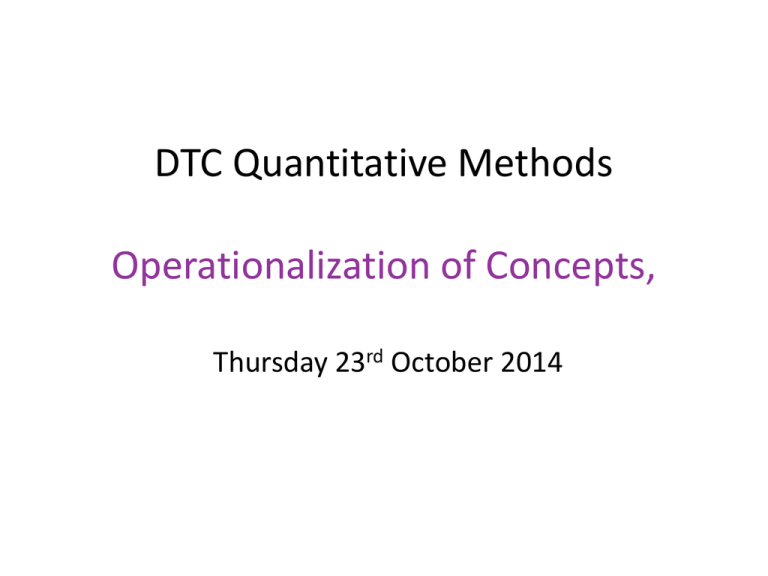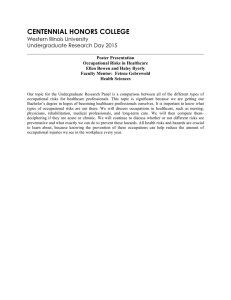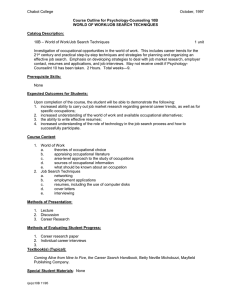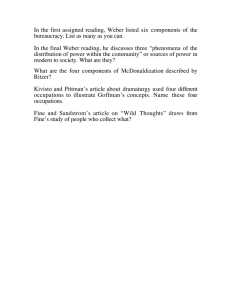DTC Quantitative Methods Operationalization of Concepts, Thursday 23 October 2014
advertisement

DTC Quantitative Methods
Operationalization of Concepts,
Thursday 23rd October 2014
Operationalizing concepts
Qualitative research: concepts are often derived from
data (e.g. via ‘Grounded Theory’)
Quantitative research: data are ‘collected’
(constructed) using pre-determined measures of the
concepts of interest
•The operationalization of concepts is a vital process in
terms of the validity and reliability of the data
collected. How good are the measures used as
indicators of the concepts of interest?
(For a discussion of these issues see the online course extract from De
Vaus, 2002).
How theory and data are linked…
THEORY
CONCEPTS
DATA
QUESTIONS
CODING
SUB-CONCEPTS
INDICATORS
The relationship between ‘class’ and ‘health’
Table 1: Death rates by sex and social (occupational) class (15-64 years)
Rates per 1000 population England and Wales 1971
Males
Females (if married,
classified by
husband’s occ.)
Ratio M/F
I (Professional)
3.98
2.15
1.85
II (Intermediate)
5.54
2.85
1.94
IIIn (Skilled non-manual)
5.80
2.76
1.96
IIIm (Skilled manual
6.08
3.41
1.78
IV (Partly Skilled)
7.96
4.27
1.87
V (Unskilled)
9.88
5.31
1.86
Ratio V/I
2.5
2.5
Social (occupational)
class
• Source: Occupational Mortality 1970-72 (Decennial supplement).
• Adapted from: Townsend, P. and Davidson, N. 1982. Inequalities in Health:
the Black Report. Harmondsworth: Penguin.
Standardization of rates
• When examining the relationship between class and health,
it will often be desirable to control for other factors, for
example, via a statistical multivariate analysis.
• More specifically, it is common to present death rates
which are standardised for age, such as the Standardised
Mortality Ratio (SMR; as discussed by Marsh and Elliott,
2009, and earlier by Marsh, 1988#).
• Such measures remove the impact of age structure on
rates, and thus allow appropriate comparisons to be made
over time, or between countries with different age
structures.
[#Marsh, C. 1988. Exploring Data. Cambridge: Polity Press.]
Measuring inequality
• Marsh and Elliott (2009) also discuss some other
‘specific’ quantitative measures, such as the Gini
coefficient for measuring (income) inequality
• This can be adapted for use in measuring some forms
of health inequalities, occupational segregation, etc.
• Overtly quantitative disciplines such as economics
and demography can be useful sources of measures
that can be adapted for specific purposes by
researchers in other social science disciplines!
Social mobility table
Class distribution of respondents by class of father at respondent’s age 14
Respondent
Father
I
II
III
IV
V
VI
VII
I
311
130
79
46
33
37
44
II
161
128
66
33
53
59
47
III
128
109
89
51
89
108
113
IV
124
128
81
187
88
134
144
V
154
147
109
83
170
229
180
VI
201
227
216
165
319
789
660
VII
151
181
187
121
274
527
685
Adapted from Table 2.2 in Goldthorpe, J.H. with Llewellyn, C. and Payne, C.
1987. Social Mobility and Class Structure in Modern Britain (2nd edition). Oxford:
Clarendon Press. [Page 49].
How should class be measured?
• The preceding slide shows a table constructed using the Goldthorpe
class schema – but what do the categories mean?
• Social class is an interesting concept, as it is a common features of
‘lay’ discussions without being especially clearly define. One might
therefore usefully ask : ‘What IS social class?’
• Or, if one is happy to restrict attention to occupational social class:
‘What are the theoretically important characteristics of occupations
that should be used to allocate occupations to particular social
classes?’
• Goldthorpe classes are, supposedly, (neo-)Weberian in theoretical
origin, reflecting the different market and work situations of people
with different occupations (and emphasising features such as
economic prospects, and authority and autonomy at work.)
• Another sociological class schema owes more theoretically to Marx:
Erik Olin Wright’s neo-Marxist class schema (Wright, 1985).
Wright, E.O. 1985. Classes. London: Verso.
An aside on odds ratios as a measure of
differences between groups/inequality:
• Returning to the measurement of inequality, the patterns in
the earlier social mobility table can be expressed as
differences in percentages (e.g. the differences between
the percentages of sons with fathers in classes I and VII
who are themselves in classes I and VII.
• However, an alternative way of quantifying these class
differences is to compare the odds of class I fathers having
sons in class I as opposed to class VII with the odds of class
VII fathers having sons in class I as opposed to class VII.
• The ratio of these two sets of odds is an odds ratio, which
will have a value of close to 1.0 if the two sets of odds are
similar, i.e. if there is little or no difference between the
chances of being in classes I and VII for sons with fathers in
classes I and VII respectively.
Pros and cons of different class measures
• Wright’s classes are not very good predictors of empirical outcomes
• His schema has a high level of content validity (i.e. it looks credible
in theoretical terms) but is less good in terms of construct validity.
• Conversely, Registrar General’s Social Class (RGSC), which was used
in UK official statistics until 2001, was frequently criticised for its
lack of clear theoretical underpinnings but related relatively
strongly to class-related outcomes (i.e. it was better in terms of its
construct validity).
• An awareness of the limitations of Registrar General’s Social Class
(and a more detailed set of occupational categories, SocioEconomic Groups) led to an ESRC (Economic and Social Research
Council) Review of the OPCS (since renamed ONS [Office for
National Statistics]) Social Classifications
• This aimed to produce more theoretically and empirically
satisfactory sets of social classifications (Rose and O’Reilly, 1997).
Rose, D. and O’Reilly, K. (eds) 1997. Constructing Classes: Towards a New Social Classification
for the UK. Swindon: ESRC/Office for National Statistics.
NS-SEC
• The revised social classification is discussed in Roberts
(2001: online course extract; see also Rose and
Pevalin, 2002; Rose et al., 2005).
• Its finalised version, NS-SEC (the National Statistics
Socio-Economic Classification) is now a standard
feature of British official statistics (for example, it has
been used in analyses of the 2001 Census data).
• NS-SEC echoes key aspects of the conceptual basis of
Goldthorpe’s schema.
• Further details can be found within the ONS ‘Guidance
and Methodology’ web pages under ‘Standard
Classifications’.
…so what is ‘class’?
• To quote from the ONS web pages, “The NS-SEC has
been constructed to measure the employment
relations and conditions of occupations (see
Goldthorpe 2007). Conceptually, these are central to
showing the structure of socio-economic positions in
modern societies and helping to explain variations in
social behaviour and other social phenomena.”
• Of course, an implication of this is that UK official
statistics conceptualise ‘class’ in a particular way,
theoretically-speaking (and they don’t call it ‘class’!)
Occupational categories
• Sets of class categories such as those described in the preceding
slides are typically based on a list of occupations known as the
Standard Occupational Classification, or SOC (ONS, 2000).
• There is also a similar, international list: ISCO {International
Standard Classification of Occupations}. See
http://www.ilo.org/public/english/bureau/stat/isco/index.htm
• Occupations are matched to one of the occupations on this list,
and cross-classified with an individual’s employment status to
identify to which category (or sub-category) of the schema in
question that individual belongs.
• A quite detailed set of questions needs to be asked for an
individual’s occupation to be matched in an unambiguous way to
one of the SOC occupations and/or to a class category.
Why seven classes? Why not a scale?
• How many classes should one bring into
consideration in a piece of research?
• Why use a set of categories (i.e. a
nominal or ordinal-level variable) rather
than a position on a scale (interval-level
variable)?
Perspective and pragmatism
• An answer to the above questions is likely to mix theoretical and practical
considerations. However, the need for aggregating categories to produce a
smaller number of ‘classes’ in some circumstances is fairly clear, which has
the implication that we need to be able to ‘recode’ variables in our
statistical analyses
• It is notable that there is a high profile occupational scale (the Cambridge
Scale; see Prandy, 1990) in British sociological research, and, perhaps
more importantly, that North American social researchers also often use
the position of occupations on a scale to measure ‘Socio-Economic Status’
(SES).
• Scales and sets of categories have different pros and cons (e.g. in terms of
the level of detail measured/represented), and lead to the use of different
techniques of statistical analysis.
• It is worth noting that the Cambridge scale is derived empirically by
looking at the behaviour of people with different occupations rather than
allocating occupations to categories on a more overtly ‘conceptuallydriven’ basis. But, either way, the discussion so far has focused on
‘objective’ measures of class, rather than subjective self-identified
measures.
Prandy, K. 1990. ‘The Revised Cambridge Scale of Occupations’, Sociology, 24.4: 629-655.
Class… and gender
• If we were considering the social classes of
married women in a piece of research, should
we consider their own occupations, or the
occupations of their husbands?
• Does it make any difference whether we are
thinking about: (i) their attitudes towards
work; (ii) their material circumstances; (iii)
their voting behaviour; (iv) the occupational
attainment of their children?
Politics and practicalities
• There has been a long-standing sociological debate
on this issue. See Roberts (1993) for a discussion.
Presumably one should work on the basis of the
relative theoretical and empirical merits of different
approaches!
• Note that a decision to base a married person’s class
on both their own and their partner’s occupation can
lead to a need to aggregate information from two
variables and derive a new variable for one’s
statistical analyses.
Roberts, H. 1993. ‘The women and class debate’. In Morgan, D. and Stanley, L.
(eds) Debates in Sociology. Manchester: Manchester University Press.
Is social position best thought of in terms
of ‘class’?
• It is worth noting that recent political discussions of social
mobility (e.g. a November 2008 Cabinet Office Strategy Unit
document: see the link below) draw upon evidence of
intergeneration income mobility as much as upon evidence of
intergenerational class mobility, suggesting that social
position (in the context of the concept of ‘social mobility’) is
being viewed as much in terms of income as in terms of class!
http://www.cabinetoffice.gov.uk/media/cabinetoffice/strategy/assets/socialmobility/gettingon.pdf
• More generally, in recent years a number of authors have
suggested that it may be appropriate to bring additional
dimensions into considerations of ‘class’/’social’ position, over
and above the ‘occupational dimension’ (e.g. an ‘educational’
dimensions, leading to considerations of educational mobility)
Bourdieu and the power of the media…
• In 2013 a new set of social classes was brought to
the attention of the UK public…
• These seven classes reflect a number of
underlying dimensions (namely economic capital,
cultural capital and social capital), and reflect, both
conceptually and methodologically, the influence
of the French social theorist Bourdieu.
• But are they valid (in multiple senses of the word
‘valid’?
(See the ‘Manchester approach’ link on the module web page).
Using existing measures of concepts
Reasons for using existing measures of concepts:
• Availability (although even secondary analysts may be able to reconfigure
data to produce their own measures or variants of measures, e.g. a
different class schema)
• Comparability
• The time and effort saved
• Existing measures also may have the benefit of being ‘tried and trusted’
(e.g. thoroughly piloted).
However, the crunch question is whether there is an adequate match in terms
of validity between the concept as operationalized and the researcher’s
intended use for it.
For those considering using existing measures/questions, the The Survey
Question Bank (SQB) (see web pages) is an helpful on-line resource containing
measures and questions from various high profile UK government and
academic surveys.
A doctoral example: Measuring cultural capital
In her research on cultural capital and educational attainment, Sullivan
operationalises the former concept (as discussed by Bourdieu)
multidimensionally, using the following types of indicator, which were
included as six explanatory variables in her statistical analyses of GCSE results:
“1. Activities
• Reading: type and amount of books read, library use, newspapers read.
• Television: type of programmes watched.
• Music: type of music listened to, playing an instrument
• Participation in ‘public’ or ‘formal’ culture: art gallery, theatre and concert attendance.
2. Cultural knowledge
• Tested knowledge of famous cultural figures.
•
3. Language
• Active and passive vocabulary test scores.”
From: Sullivan, A. 2001. ‘Cultural Capital and Educational Attainment’, Sociology 35.4:
893-912. [p899]
...and an official example: Social capital
• An operational definition and indicator/set of indicators for
this concept, as written about by Bourdieu, Coleman, Putnam,
etc., has been developed on behalf of the Health
Development Agency using questions within the General
Household Survey
• See the National Statistics website for relevant material. (The
material is listed under the heading ‘The Social Capital
Project’ within the ‘Guidance and Methodology’ section).
• The questions used to tap this multi-dimensional concept
relate to civic engagement and aspects of
neighbourhoods/local areas, social networks and support,
trust and mutual reciprocity, etc.







